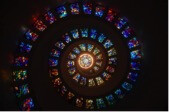Series: February 2023
Speaker: Rob McClellan

Today's Sermon
"A Resurrection People"
Scripture Reading
Luke 24:13-35
13Now on that same day two of them were going to a village called Emmaus, about seven miles from Jerusalem, 14and talking with each other about all these things that had happened. 15While they were talking and discussing, Jesus himself came near and went with them, 16but their eyes were kept from recognizing him. 17And he said to them, “What are you discussing with each other while you walk along?” They stood still, looking sad. 18Then one of them, whose name was Cleopas, answered him, “Are you the only stranger in Jerusalem who does not know the things that have taken place there in these days?” 19He asked them, “What things?” They replied, “The things about Jesus of Nazareth, who was a prophet mighty in deed and word before God and all the people, 20and how our chief priests and leaders handed him over to be condemned to death and crucified him. 21But we had hoped that he was the one to redeem Israel. Yes, and besides all this, it is now the third day since these things took place. 22Moreover, some women of our group astounded us. They were at the tomb early this morning, 23and when they did not find his body there, they came back and told us that they had indeed seen a vision of angels who said that he was alive. 24Some of those who were with us went to the tomb and found it just as the women had said; but they did not see him.” 25Then he said to them, “Oh, how foolish you are, and how slow of heart to believe all that the prophets have declared! 26Was it not necessary that the Messiah should suffer these things and then enter into his glory?” 27Then beginning with Moses and all the prophets, he interpreted to them the things about himself in all the scriptures.
28As they came near the village to which they were going, he walked ahead as if he were going on. 29But they urged him strongly, saying, “Stay with us, because it is almost evening and the day is now nearly over.” So he went in to stay with them. 30When he was at the table with them, he took bread, blessed and broke it, and gave it to them. 31Then their eyes were opened, and they recognized him; and he vanished from their sight. 32They said to each other, “Were not our hearts burning within us while he was talking to us on the road, while he was opening the scriptures to us?” 33That same hour they got up and returned to Jerusalem; and they found the eleven and their companions gathered together. 34They were saying, “The Lord has risen indeed, and he has appeared to Simon!” 35Then they told what had happened on the road, and how he had been made known to them in the breaking of the bread.
“A Resurrection People”
In her contribution to a collection rethinking the meaning of Jesus’ crucifixion, theologian Rita Nakashima Brock writes, “It took Jesus a thousand years to die. An image of Jesus dead does not appear in Europe until 960-970. Once he dies, that is all he seems to do.”[1] You and I are accustomed to images of the crucified Jesus. We may assume that’s the way it’s always been, but not so. Jesus’ body didn’t appear with the cross until the 5thcentury, and then he was not depicted as suffering and dying. Rather it was Christ triumphant, praying in paradise.[2] The cross wasn’t even the original Christian symbol, but when it rose to prevalence it was a resurrection symbol. Brock’s chapter is called “The Cross of Resurrection and Communal Redemption” which reveals her emphasis and attempt at corrective balance.
Tellingly, images of the crucifixion appear only afterChristians began to engage in widespread violence against pagans.[3]In other words, over time Christians strangely made crucifixion a point of emphasis and made it habit to be imitators of crucifixion rather than imitators of resurrection. Jesus’ first calling, the calling of his first followers, and our true calling is to be a resurrection people not a crucifixion people relying on violence. Have we thought about how deeply we’ve internalized violence as a way to get things done? It’s engrained in our culture. I listen to a podcast on which Mike Schur, Hollywood writer and interesting recent author of a book on morality,[4]appears. The other day, Schur was marveling how a single curse word or heaven forbid showing a certain body part earns a “R” rating. Blow countless things and people up, however, and it raises no issue. We’ve decided that violence is acceptable, and we’re seeing the results play out on a daily basis. Do we want to keep being crucifixion people or are we ready to be a resurrection people?
The risen Jesus appears to two of his disciples while they’re still basking in the resurrection, notice not the crucifixion. They do not recognize him in his changed state and so he just walks alongside them down the road they are traveling – there’s an image for you. Jesus lets them tell the story of him, letting them practice on him – there’s an image for you. Finally, he takes over the teaching. It’s only later when they break bread together their eyes are opened to who he is – there’s an image for you. Once they recognize his presence, he vanishes – there’s an image for you! They reflect, “Were not our hearts burning within us while he was talking to us on the road, while he was opening the scriptures to us?” (Lk. 24:32). This is how they know it’s of God, that their hearts were burning. Do we trust our hearts? Not our solitary hearts – notice the disciples are always at least in twos to ensure one doesn’t misinterpret the signal because we can get it wrong.
I don’t like to focus on how we can get it wrong, which may surprise you because I talk about it a lot. I do so not because I like dwelling in what we’ve gotten wrong, but because it’s only in identifying it, coming to terms with it, that we can get about making the adjustment, getting it more right, and there is so much that’s right about the way of Jesus. Over spring break, we went down to Pinnacles National Park near Hollister. It was gorgeous. At night we gazed countless stars in the unpolluted sky. By day, we counted the condors soaring above, a resurrection success story in its own right. On our way home, we stopped in the historic town of San Juan Bautista (St. John the Baptist) founded in the late 18thcentury. I have to admit I was a little reluctant to go there and see the mission for which it’s famous. My son is in 4thgrade and thus is studying California history. He’s already visited one mission and I heard from chaperones descriptions of the awful conditions under which it was built and the native peoples who suffered and lost their lives there, including many children.
I decided it’s better to see than turn away, so I wandered over to the mission. The first thing I came to was the cemetery, marked by a sign I captured with my phone’s camera: BURIED IN THIS SACRED GROUND IN UNMARKED GRAVES ARE ABOUT 4300 MISSION INDIANS, SPANISH AND PIONEER SETTLERS. Something burned in me, but it wasn’t my heart. That just ached. I was ashamed, ashamed at what was done in the name of Christ. As I looked around at the Catholic iconography, I wondered how odd it must have been for indigenous peoples to be forcefully told to worship inside buildings first of all, to worship a “loving” God made manifest by an episode wherein his son was depicted as a white man nailed to a cross, one who they needed to “accept” or be sent to hell. It must have been utterly alien to them. It feels that way to many of us.
This, of course, leads us back to the cross asking the same questions theologians such as Brock are asking. What does it mean? Does it only mean God shows up in death, more specifically in killing? I find it no coincidence that some who share my own faith defend their right to carry weapons on not just civil but religious grounds. Whether they know it or not they are carrying around a theology of crucifixion, the God-given right to kill. What Jesus reveals on the cross is not the sacredness of crucifixion—of course not—but the power, promise, and possibility of resurrection. And the truth of resurrection is not just that we get to come out of death on the other end fine. Rather, in Christ we are raised to new life starting now, a new way of being together now. That’s certainly what the early Christians understood. That’s what we say when we baptize, as we did last week and we are doing this week, that we have died with Christ and risen with Christ. In baptism we are ritually inviting and promising a new way of life. That’s the real legacy of the real St. John the Baptist.
The world has its share of missionaries of crucifixion; what it needs are disciples of resurrection, students of new life, practitioners of shalom, God’s peace lived out on earth. Heaven’s in good shape. It’s the world that needs our attention. Just because we won’t always get it right doesn’t mean it’s not worth trying, offering our best understanding of how Jesus calls us, inspires us, and equips us to live in the world. There are plenty of others plenty happy to offer their versions. Now this is the point where I’m supposed to give you a moving illustration of someone doing precisely this, living the resurrection life, and there is merit in that. There is also something misleading about it. We often reduce it to someONE. Our default is to individualize everything, something Jesus himself guarded against. Again, Jesus sent out his disciples, a community of students, in twos. What I should do, what we should be doing, is finding and becoming communities of people getting it right. These examples may be harder to find. Somewhere like Canticle Farms in Oakland might be one example, an urban garden, education and advocacy center.
We are to be a resurrection people, forming as Jeff Shankle put it last week, bubbles or pockets throughout the world where earth looks a little more like heaven. We know others have something to contribute to that divine design, that we don’t have a patent on the plans, but the way of Jesus does have a special gift to offer. We may have some studying to do. If we are to truly follow the Christ of the empty tomb, we have to learn to practice resurrection as a people. In her essay on resurrection and, in the face of violence, communal redemption—not just individual redemption but communal redemption—Brock writes:
Violence in its worst forms is socially organized and transpersonal, in which individual intent rarely matters [we obsess over individual intent]. Under dire conditions, a person or community may resort to violence, but violence is always unholy because it threatens not just the individual soul [we make it all about the individual soul], but the entire social nexus of life. Effective resistance to violence comes through community capacities to maintain accurate, integrated memory, to enable recovery from and make restitution for harm, and to negotiate the complex and ambiguous responses to violence that result from its eruptions. A community must expect restitution for harm [which repairs communities] from those who inflict it, regardless of their intentions, rather than focusing justice on the punishment of perpetrators [crucifixion mentality]. In the absence of means for restitution, nonviolent responses to harm must be ritualized and enacted communally.[5]
Let’s find examples of that. Let’s become examples. Let’s put our God-given imagination and creativity to use for that great end. That’s part of what it means to be a resurrection people. It took Jesus a thousand years to die. He’s been doing far too much dying since. It’s about time he lives again in the communal lives of his followers.
Amen.
[1]Rita Nakashima Brock, “The Cross of Resurrection and Communal Redemption” in Cross Examinations: Readings on the Meaning of the Cross Today, ed. Marit Trelstad (Minneapolis: Augsburg Fortress, 2006), 242.
[4]Michael Schur, How to Be Perfect: The Correct Answer to Every Moral Question(New York: Simon & Schuster, 2002).

